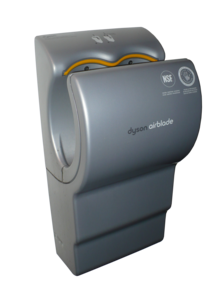Dyson Airblade
 |
|
| Launch year | 2006 |
|---|---|
| Company | Dyson |
| Availability | Available |
The Dyson Airblade is a model of electric hand dryer made by the Wiltshire, UK based company Dyson. It was introduced in the UK in 2006 and in the United States in latter part of 2007.
Instead of using a wide jet of heated air, it uses a thin layer of unheated air traveling at around 400 mph (180 m/s; 640 km/h) as a squeegee to remove water, rather than using heat to evaporate the water. The Dyson Airblade is claimed by its manufacturer to dry hands in 10 seconds and to use less electricity than conventional hand dryers.
The first commercially available high-speed, horizontal-wiping air dryer was the Mitsubishi Jet Towel, invented in 1993 and available in the United States since 2005. There are several technical differences among electric hand dryers, such as airspeed, water containment, energy efficiency, use of heat, type of filter, motor lifespan and power usage.
Since its release, the Dyson Airblade has won several awards including the Best Overall Product at Interbuild 2007 and Best workplace product innovation.
The same technology is used by Dyson in the Air Multiplier fan to create a cooling air stream for personal comfort.
The Airblade can be more energy-efficient than conventional hand-dryers because it does not use electric heating; it also can run for a shorter time than conventional driers.
A comparative test found that both paper towels and the Airblade dried hands quickly, achieving 90% dryness in about ten seconds, supporting Dyson's claim of ten seconds drying time. A conventional warm air dryer took 47 seconds.
In the United States, Dyson worked with the NSF to become the only certified hand dryer under Protocol P335 for Hygienic Commercial Hand Dryers The Royal Society of Public Health has given the Dyson Airblade hand dryer its first hygiene accreditation.
A paper was presented at the 17th European Congress of Clinical Microbiology and Infectious Diseases, Munich, Germany in 2007 by the University of Bradford and Dyson showing that for a set drying time of 10 seconds, the Airblade led to significantly less bacterial transfer than with the other driers (p < 0.05). When the latter were used for longer (30–35 s) the trend was for the Airblade to still perform better; however, these results did not reach statistical significance (p > 0.05). In addition the study showed that rubbing hands whilst using the driers counteracted the reduction in overall bacterial numbers at all anatomical sites.
...
Wikipedia
